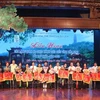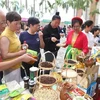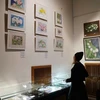More than 200 Japanese dolls, mainly Kimekomi dolls, are being showcased at the Vietnamese Women’s Museum in Hanoi as part of activities to celebrate the Japan-Vietnam Friendship Year 2013 and International Women’s Day.
The March 6-31 exhibition is jointly organised by the Vietnamese Women’s Museum and the Japan Foundation Center for Cultural Exchange in Vietnam , in cooperation with the Japanese Embassy in Vietnam , and the Traditional Edo-kimekomi Dolls Saciei-kai and Kimono Cultural Exchange Associations.
Kimekomi dolls, which are made of willow-wood and decorated with cloth scraps, were first made in the Japanese ancient capital of Kyoto in the 17 th century. The hand-made dolls are believed to drive away devils and diseases while protecting old people and children.
Meanwhile, the Japan Foundation Center for Cultural Exchange presents a collection of around 40 selected Japanese dolls, including female dolls dressed in kimonos, dolls depicting characters from traditional Japanese performing arts like Noh and Kabuki, Hakata dolls or clay dolls, and Kokeshi dolls with their unique character.
“Dolls” have been a part of everyday life in Japan since the ancient time. They reflect the customs of Japan and the aspirations of its people, possess distinctive regional attitudes, and over the centuries have developed in many diverse forms.
Japanese dolls now can be categorised in many ways according to the techniques and material used to create them, as well as the themes and shapes of the dolls.-VNA
The March 6-31 exhibition is jointly organised by the Vietnamese Women’s Museum and the Japan Foundation Center for Cultural Exchange in Vietnam , in cooperation with the Japanese Embassy in Vietnam , and the Traditional Edo-kimekomi Dolls Saciei-kai and Kimono Cultural Exchange Associations.
Kimekomi dolls, which are made of willow-wood and decorated with cloth scraps, were first made in the Japanese ancient capital of Kyoto in the 17 th century. The hand-made dolls are believed to drive away devils and diseases while protecting old people and children.
Meanwhile, the Japan Foundation Center for Cultural Exchange presents a collection of around 40 selected Japanese dolls, including female dolls dressed in kimonos, dolls depicting characters from traditional Japanese performing arts like Noh and Kabuki, Hakata dolls or clay dolls, and Kokeshi dolls with their unique character.
“Dolls” have been a part of everyday life in Japan since the ancient time. They reflect the customs of Japan and the aspirations of its people, possess distinctive regional attitudes, and over the centuries have developed in many diverse forms.
Japanese dolls now can be categorised in many ways according to the techniques and material used to create them, as well as the themes and shapes of the dolls.-VNA



















